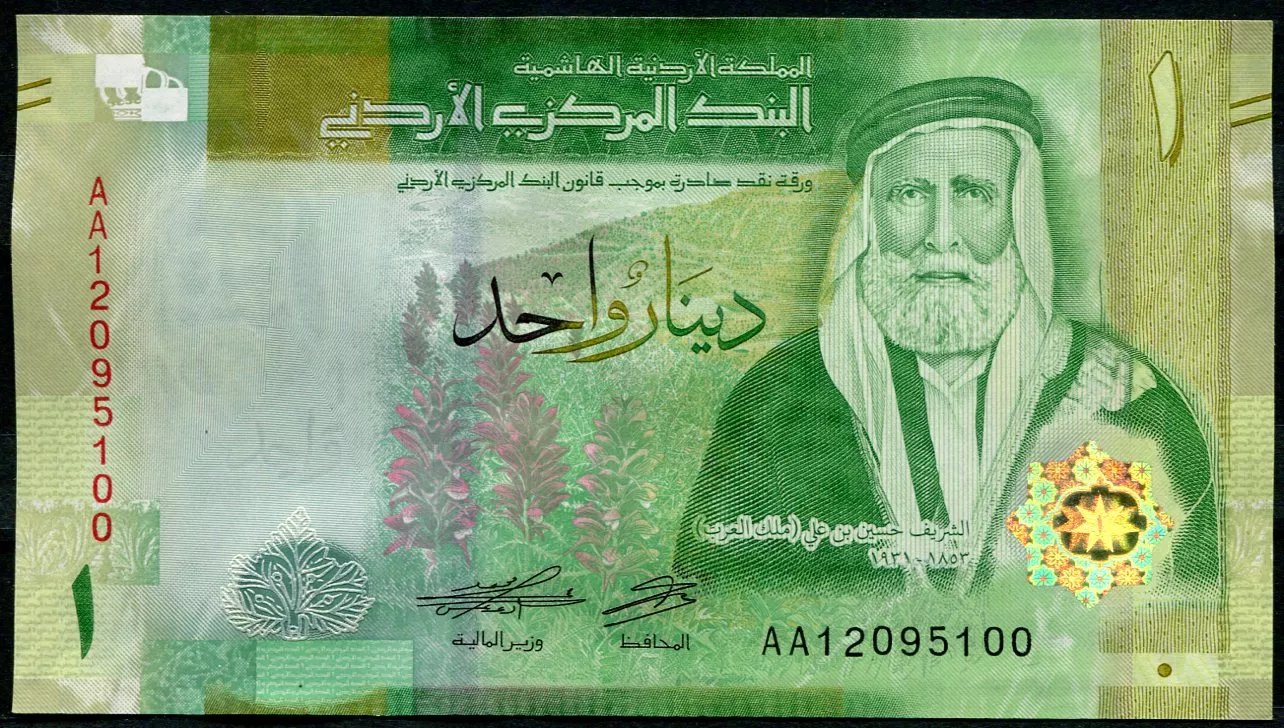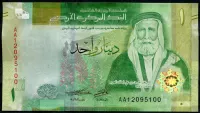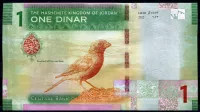- Home
- Notafilia: banknotes
- Banknotes: Middle East
- Jordan
- Jordan (P 39a) 1 Dinar (2022) - UNC
Jordan (P 39a) 1 Dinar banknote (2022) - UNC AA series
Banknotes - Middle East - Jordan



| Code: | JRD-P39a-AA |
| Producer: | Jordánsko |
| Price: | 4,11 EUR |
| Availability: | In Stock ( AA series ) |
| Stock: | 16 Pcs |
| In stock (all variants): | 16 Pcs |
| State: | UNC |
| Year: | 2022 |
| Catalogue Number: | P 39a |
Hussein bin Ali al-Hashimi - the last Sharif of Mecca and founder of the Arab nationalism movement
Hussein bin Ali al-Hashimi (1853-1931) is a historically significant figure in the Middle East at the turn of the 19th and 20th centuries. A descendant of the Prophet Muhammad of the House of Hashim (Banu Hashim), he held the prestigious title of Sharif and Emir of Mecca, the custodian of the holy city of Hijaz, in what is now western Saudi Arabia. He is best known as the leader of the so-called Arab Revolt against the Ottoman Empire during World War I and as one of the central figures in the birth of modern Arab nationalism.
Historical Background
In the period before World War I, the Arabian Peninsula was formally part of the Ottoman Empire, although central authority was only symbolic in some areas. Hussein bin Ali was appointed Sharif of Mecca by the Ottoman government in 1908, during the period of constitutional reforms. However, with the growing influence of the Young Turk movement and the drive for centralization, Hussein came into increasing conflict with Istanbul.
Arab Revolt (1916-1918)
A key moment in Hussein's life was the announcement of the Arab Revolt in June 1916. The move was the result of secret correspondence with British High Commissioner Henry McMahon, in which Britain promised to support the establishment of an independent Arab kingdom in exchange for support against the Ottomans.
Under the leadership of Hussein and his sons, notably Faisal and Abdullah, there were military operations against Ottoman forces, often in coordination with British forces, among whom was the famous T. E. Lawrence (the so-called Lawrence of Arabia). The uprising was successful and contributed to the weakening of the Ottoman Empire in the Arabian Peninsula.
Political ambitions and their fall
After the war ended, Hussein expected to be recognized as king of a unified Arab state. Instead, however, the Western powers divided the former Ottoman territories into mandate administrations - the British took control of what is now Iraq, Jordan and Palestine, and the French took control of Syria and Lebanon. Hussein proclaimed himself King of the Arab Kingdom of Hijaz in 1916, and in 1924 he assumed the title of Khalifa, a move that provoked resentment in the wider Muslim world and among the then ruler of the Najd, Abd al-Aziz ibn Saud.
In 1925, Hussein was defeated and forced to flee. His kingdom was annexed to the newly formed Saudi Arabia. He died in exile in Amman in 1931.
Heritage
Although Hussein bin Ali did not obtain the pan-Arab kingdom he sought, his descendants ruled and continue to rule in several Arab states. His son Faisal became king of Iraq, while his other son Abdullah was appointed emir of Transjordan and later king of Jordan. The Jordanian royal family of the Hashim family are direct descendants of Hussein bin Ali.
Frequently Bought Together - Jordan (P 39a) 1 Dinar banknote (2022) - UNC
From the Same Category - Jordan (P 39a) 1 Dinar banknote (2022) - UNC
Banknotes - Middle East - Jordan 2012 (1433H) Sultan Qaboos bin Said Al Said (1940-2020) Sultan Qaboos bin Said Al Said (1940-2020) was the ruler of Oman from 1970 until his death in 2020. He ascended the throne after a coup against his father, ...
Jordan - banknotes
